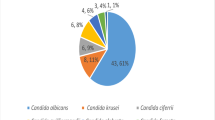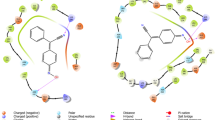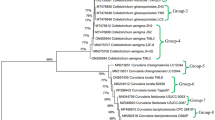Abstract
Vulvovaginal candidiasis (VVC) affects millions of women around the world every year. Candida albicans is the most frequently isolated pathogen in women and its rapid ability to develop resistance to first and second line therapies has boosted the search for new and effective antifungal agents. In this study, we show the in vitro anti-Candida activity of fifteen synthetic chalcone analogs and their antifungal potential in an in vivo model of VVC. Chalcone 12 showed potent antifungal effects, being able to inhibit the growth of Candida spp. at a concentration of 15.6 µg mL−1. In addition, mechanism of action studies have indicated the ergosterol fungal membrane as the target of this compound. Despite a considerable antifungal activity, the chalcone 12 showed high cytotoxicity in kidney cells lineages. Moreover, this compound was able to reduce Candida-associated virulence, impairing yeast–hyphal transition in C. albicans. An in vivo model of VVC showed that chalcone 12 significantly reduces the fungal load. Taken together, these findings showed that the chalcone 12 is a potent anti-Candida agent in vitro beyond of contribute to improve the fungal infection in a model of CVV. However, it showed low selectivity and high toxicity, suggesting molecular modifications to minimize these proprieties.
Similar content being viewed by others
Log in or create a free account to read this content
Gain free access to this article, as well as selected content from this journal and more on nature.com
or
References
Olowe OA, Makanjuola OB, Olowe R, Adekanle DA. Prevalence of vulvovaginal candidiasis, trichomoniasis and bacterial vaginosis among pregnant women receiving antenatal care in southwestern Nigeria. Eur J Microbiol Immunol. 2014;4:193–7.
Sobel JD. Vulvovaginal candidosis. Lancet. 2007;369:1961–71.
Ventolini G, Baggish MS. Recurrent vulvovaginal candidiasis. Clin Microbiol Newsl. 2006;28:15–21.
Ahmad A, Khan AU. Prevalence of Candida species and potential risk factors for vulvovaginal candidiasis in Aligarh, India. Eur J Obstet Gyn Reprod Biol. 2009;144:68–71.
Pappas PG, et al. Clinical practice guideline for the management of candidiasis: 2016 update by the infectious diseases society of america. Clin Infect Dis. 2016;62:1–50.
Silva S, et al. Candida glabrata, Candida parapsilosis and Candida tropicalis: biology, epidemiology, pathogenicity and antifungal resistance. Fems Microbiol Rev. 2012;36:288–305.
Cleveland AA, et al. Changes in incidence and antifungal drug resistance in candidemia: results from population-based laboratory surveillance in Atlanta and Baltimore, 2008–2011. Clin Infect Dis. 2012;55:1352–61.
Maurya IK, et al. Mechanism of action of novel synthetic dodecapeptides against Candida albicans. Biochim Biophys Acta. 2013;1830:5193–203.
Sahu NK, Balbhadra SS, Choudhary J, Kohli DV. Exploring pharmacological significance of chalcone scaffold: a review current. Med Chem. 2012;19:209–25.
Hu Y, Keniry M, Palmer SO, Bullarda JM. Discovery and analysis of natural-product compounds inhibiting protein synthesis in Pseudomonas aeruginosa. Antimicrob Agents Chemother. 2016;60:4820–9.
Passalacqua TG, et al. 2′,4′-dihydroxychalcone could be explored to develop new inhibitors against the glycerol-3-phosphate dehydrogenase from Leishmania species. Bioorg Med Chem Lett. 2015;17:3564–8.
Batovska D, et al. Study on the substituents’ effects of a series of synthetic chalcones against the yeast Candida albicans. Eur J Med Chem. 2007;42:87–92.
Konduru NK, Dey S, Sajid M, Owais M, Ahmed N. Synthesis and antibacterial and antifungal evaluation of some chalcone based sulfones and bisulfones. Eur J Med Chem. 2013;59:23–30.
Kant R, et al. Synthesis of newer 1,2,3-Triazole linked chalcone and flavone hybrid compounds and evaluation of their antimicrobial and cytotoxic activities. Eur J Med Chem. 2016;113:34–49.
Yadav M, Lavania A, Dasaray K, Anand AVK. Synthesis of chalcone and their derivatives as antimicrobial agents by using Poly Ethylene Glycol PEG(400). J Appl Chem. 2016;5:136–41.
Still WC, Kahn M, Mitra A. Rapid chromatographic technique for preparative separations with moderate resolution. J Org Chem. 1978;43:2923–25.
Evangelista FCG, et al. Synthesis and in vitro evaluation of novel triazole/azide chalcones. Med Chem Res. 2016;26:27–43.
Sander T, Freyss J, Von KM, Rufener C. DataWarrior: an open-source program for chemistry aware data visualization and analysis. J Chem Inf Model. 2015;55:460–73.
Leeson P. Drug discovery: chemical beauty contest. Nature. 2012;481:455–6.
Souza MA, et al. The antimicrobial activity of lapachol and its thiosemicarbazone and semicarbazone derivatives. Mem Inst Oswaldo Cruz. 2013;108:342–51.
Lima WG, et al. Absence of antibacterial, anti-Candida, and anti-dengue activities of a surfactin isolated from Bacillus subtilis. J Pharm Negat Results. 2017;8:1–6.
CLSI. Reference Method for Broth Dilution Antifungal Susceptibility Testing of Yeasts; Approved Standard. 3rd edn. Wayne, PA: Clinical and Laboratory Standards Institute; 2008. CLSI document M27-A3
Allochio Filho JF, et al. Synthesis, in vitro antifungal activity and molecular modeling studies of new mannich bases derived from lawsone. J Braz Chem Soc. 2016;27:2127–40.
Guo Z, et al. Synthesis, characterization, and antifungal activity of novel inulin derivatives with chlorinated benzene. Carbohydr Polym. 2014;99:469–73.
Escalante A, Gattuso M, Perez P, Zacchino S. Evidence for the mechanism of action of the antifungal Phytolaccoside B isolated from Phytolaccatetramera Hauman. J Nat Prod. 2008;71:1720–5.
Zore GB, Thakre AD, Jadhav J, Karuppayil SM. Terpenoids inhibit Candida albicans grow by affecting membrane integrity and arrest od cell cycle. Phytomedicine. 2011;18:1181–90.
Araújo MGF, et al. Evaluation of Syngonanthusnitens (Bong.) Ruhl. extract as antifungal and in treatment of vulvovaginal candidiasis. Med Mycol. 2013;1:1–10.
Eccleston GM. Emulsions and microemilsions. In: Swarbick J, Boylan JC, editors. Encyclopedia of Pharmaceutical Technology. 2nd ed. New York: Marcel Dekker; 2002. p. 1060–85. Vol. 2.
Soper DE. Genitourinary infections and sexually transmitted diseases. In: Berek JS, editors. Berek & Novak’s Gynecology. 14th ed. Philadelphia: Lippincott Williams & Wilkins; 2007. p. 1017–48.
Yano J, Fidel PL Jr. Protocols for vaginal inoculation and sample collection in the experimental mouse model of Candida vaginitis. J Vis Exp. 2011;58:1–7.
Carrara M, et al. A new model of vaginal infection by Candida albicans in rats. Mycopathologia. 2010;1:1–8.
Ramos MAS, et al. Syngonanthusnitens Bong. (Rhul.)-loaded nanostructured system for vulvovaginal candidiasis treatment. Int J Mol Sci. 2016;17:1–19.
Karad SC, Purohit VB, Thakor P, Thakkar VR, Raval DK. Novel morpholinoquinoline nucleus clubbed with pyrazoline scaffolds: Synthesis, antibacterial, antitubercular and antimalarial activities. Eur J Med Chem. 2016;112:270–9.
Wei Z, et al. Synthesis and biological evaluation of chalcone derivatives containing aminoguanidine or acylhydrazone moietie. Bioorg Med Chem Lett. 2016;26:5920–5.
Wong SSW, et al. In vitro and in vivo activity of a novel antifungal small molecule against Candida Infections. PLoS ONE 2014;9:1–17.
Nóbrega HN, Ferreira JAB, Romão CMCPA, Capasso IRVF. Atividade antimicrobiana in vitro de produtos antissépticos por meio de técnica. Time Kill Rev Inst Adolfo Lutz. 2013;72:226–33.
Ling LL, et al. New antibiotic kills pathogens without detectable resistance. Nature. 2015;517:455–73.
Perfect JR. The antifungal pipeline: a reality check. Nat Rev Drug Discov. 2017;12:1–14.
Sivakumar PM, Mathu KT, Doble M. Antifungal activity, mechanism and QSAR studies on chalcones. Chem Biol Drug Des. 2009;74:68–79.
Lopez SN, et al. In vitro antifungal evaluation and structure-activity relationships of a new series of chalcone derivatives and synthetic analogues with inhibitory properties against polymers of the fungal cell wall. Bioorg Med Chem. 2001;9:1999–2013.
Hameed A, et al. Anti-HIV cytotoxicity enzyme inhibition and molecular docking studies of quinoline based chalcones as potential non-nucleoside reverse transcriptase inhibitors (NNRT). Bioorg Chem. 2016;65:175–82.
Zenger K, Dutta S, Wolff H, Genton MG, Kraus B. In vitro structure-toxicity relationship of chalcones in human hepatic stellate cells. Toxicology. 2015;2:26–33.
Lee YT, et al. Toxicity assessments of chalcone and some synthetic chalcone analogues in a zebrafish model. Molecules. 2014;19:641–50.
Krcmery V, Kalavsky E. Antifungal drug discovery, six new molecules patented after 10 years of feast: why do we need new patented drugs apart from new strategies? Recent Pat Antiinfect Drug Discov. 2007;2:182–7.
Díaz-Tielas C, Graña E, Reigosa MJ, Sánchez-Moreiras AM. Biological activities and novel applications of chalcones. Planta daninha. 2016;34:607–16.
Messier C, Epifano F, Genovese S, Grenier D. Inhibition of Candida albicans biofilm formation and yeast-hyphal transition by 4-hydroxycordoin. Phytomedicine. 2011;18:380–3.
Acknowledgements
We would like to thank Universidade Federal de São João del-Rei, Conselho Nacional de Desenvolvimento Científico and Tecnológico (CNPq), Coordenação de Aperfeiçoamento de Pessoal de Nível Superior (CAPES), and Fundação de Amparo à Pesquisa do estado de Minas Gerais (FAPEMIG) by financial support. JTA and WGL are grateful to UFSJ and FAPEMIG for a fellowship, respectively.
Funding
This research did not receive any specific grant from funding agencies in the public, commercial, or not-for-profit sectors.
Author information
Authors and Affiliations
Corresponding author
Ethics declarations
Conflict of interest
The authors declare that they have no conflict of interest.
Electronic supplementary material
Rights and permissions
About this article
Cite this article
Andrade, J.T., Santos, F.R.S., Lima, W.G. et al. Design, synthesis, biological activity and structure-activity relationship studies of chalcone derivatives as potential anti-Candida agents. J Antibiot 71, 702–712 (2018). https://doi.org/10.1038/s41429-018-0048-9
Received:
Revised:
Accepted:
Published:
Issue date:
DOI: https://doi.org/10.1038/s41429-018-0048-9
This article is cited by
-
Imidazolium-based ionic liquids disrupt saccharomyces cerevisiae cell membrane integrity
Archives of Microbiology (2024)
-
Chalcone derivatives disrupt cell membrane integrity of Saccharomyces cerevisiae cells and alter their biochemical composition
Archives of Microbiology (2024)
-
Chalcone Schiff bases disrupt cell membrane integrity of Saccharomyces cerevisiae and Candida albicans cells
Archives of Microbiology (2023)
-
Novel eco-friendly [1,2,4]triazolo[3,4-a]isoquinoline chalcone derivatives efficiency against fungal deterioration of ancient Egyptian mummy cartonnage, Egypt
Archives of Microbiology (2023)
-
Mechanisms of Candida Resistance to Antimycotics and Promising Ways to Overcome It: The Role of Probiotics
Probiotics and Antimicrobial Proteins (2021)



